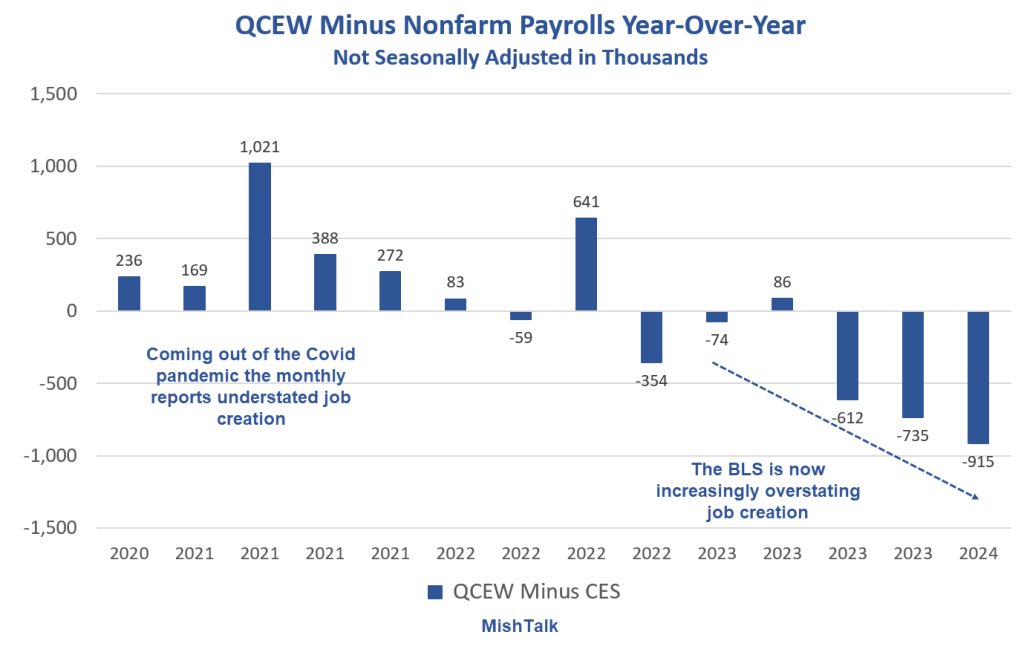Do I get to say I told you so? My advance estimate a month ago was 779,000 lower. Bloomberg estimated 730,000.

Major Downward Revisions to US Jobs Pushes the Fed to Act
ING reports Downward Revisions to US Jobs Pushes the Fed to Act
The Bureau for Labor Statistics has acknowledged that its non-farm payrolls estimates were above the levels shown by tax records to the tune of 818,000. So rather than adding 2.9mn jobs in the 12M to March 2024, there were only 2.1mn new jobs. This means labour market momentum is being lost from a weaker position than originally thought
After quite a bit of delay and confusion we have finally got the preliminary benchmark revisions to US non-farm payrolls – where the Bureau for Labor Statistics (BLS) adjusts its estimates for non-farm payrolls to reflect official tax data – the true benchmark for US employment. It is a chunky 818k, meaning that rather than 2.9mn jobs added in the 12M to March 2024, it was “only” 2.1mn – equivalent to a 0.5 percentage point error on payrolls. So rather than averaging monthly payrolls gains of 246,000 it was only 178,000.
Historically, the BLS has been out by 0.1pp with its estimates versus the tax data – that is the 10Y average. Last year they were out by 0.2pp, requiring a 306k downward revision so today’s announced change is a big error and suggests there are some clear issues regarding some of the assumptions the BLS uses to complement its surveys of US businesses. The BLS has a good handle on what is going on amongst large employers, but has less visibility on the small business sector and has a “births-death” model.
That is what I said a month ago. My estimate was 779,000. Anna Wong at Bloomberg estimated 730,000.
On July 26, 2024 I commented Expect the BLS to Revise Job Growth Down by 730,000 in 2023, More This Year
Apologies for being overly optimistic.
I am struggling to match 818,000 this morning. Using unadjusted numbers, I calculate a discrepancy of 915,000.
QCEW Minus Nonfarm Payrolls Year-Over-Year

It’s very clear what’s happening.
The BLS models went haywire after Covid. First the BLS understated jobs and now the BLS is dramatically overstating them.
Jobs up by over 2 million from a year ago might look good. But I guarantee you it won’t stick.
Revisions are increasingly negative across the board and will stay that way.
Thought of the Day
68k downward revision per month on average. (My estimate is higher). This means that productivity will be revised up while unit labor costs will be revised down.
Personal income and Gross Domestic Income will be revised downward and the personal saving rate will be reduced from its already very depressed level of 3.5 percent.
We should remember that the markets traded on this faulty data. The downward revision is confirmation that the birth/death model, which imputes the gain in jobs for small firms, is not working.
Improving the McKelvey Recession Indicator, No False Negative or Positive Signals
Yesterday, I commented Improving the McKelvey Recession Indicator, No False Negative or Positive Signals
Adding the job vacancy rate to the McKelvey (Claudia Sahm) recession signal eliminates false negatives and false positives, and provides a much faster signal than Sahm.
I note that since 1953, every time the economy was in the current state, the economy was in recession.
That does not make the odds 100 percent because everything is up to the NBER, the official arbiter of recessions.
My recession post is on the complicated side, but please check it out.
